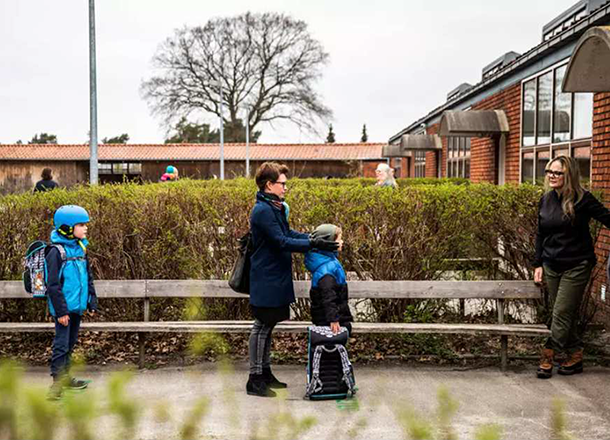
Students in Denmark cue up for school entry, guided by ground plane markings to maintain proper social distancing.
In May we held an hour-long online session with representatives from 12 Bay Area independent and charter schools to consider the challenges they face in reopening this fall. We wanted to hear their concerns and help everyone share their thoughts as we all navigate these uncharted waters.
Members of TEF’s educational design staff, including Doug Tom, Jennifer Tulley, Paul Cooper, and myself started off by presenting some of the research we’ve been conducting on the experiences of countries like Denmark and China that have already reopened schools. We then met with participants in virtual breakout rooms for some smaller group discussion before reconvening to share the results. What follows are some of the key takeaways from that session.
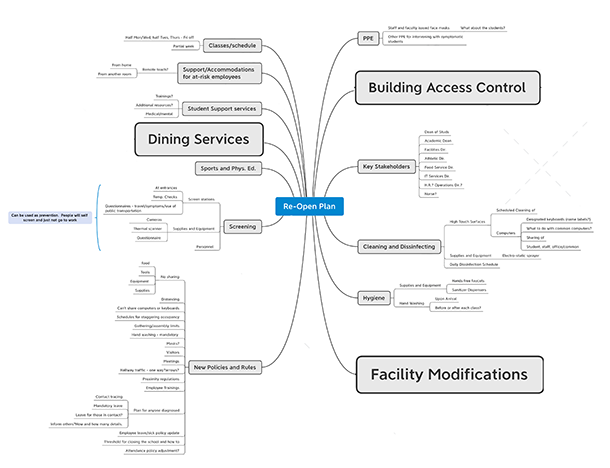
The complexity of contingency planning, depicted in a graphic by Jennifer Fox, shared during a webinar by the National Association of Independent Schools.
Planning for the Unknown
New information about the virus as well as best practices is revealed on a daily basis. One participant shared that “we’re all starting to plan, but we don’t necessarily know what we’re planning for, because things change quite rapidly.” Several people expressed frustration that after working hard to create a plan one week, they hear guidance the next week that overturns everything. For example, we don’t know if consistent groups of 12 will be required, or if all ages of students will need the current physical space of 6 feet. Then there are possibilities for accommodating physical distancing requirements that could include carving gyms into multiple learning spaces and creating pop-up sheds in outdoors spaces. But how easy will it be to obtain such permits? And how will these potential projects be funded- particularly in light of the economic impacts of COVID-19?
Schools are developing multiple contingency plans and scenarios, trying to retain enough flexibility to address the as-yet-unknown health policies that will be in place in the fall. No single plan can be the solution. We heard a lot of concern about stress and burnout for educators. And, participants acknowledged that public schools have no idea yet what’s in their control either, or their budget, and they will likely have less discretion in their strategies than private schools.
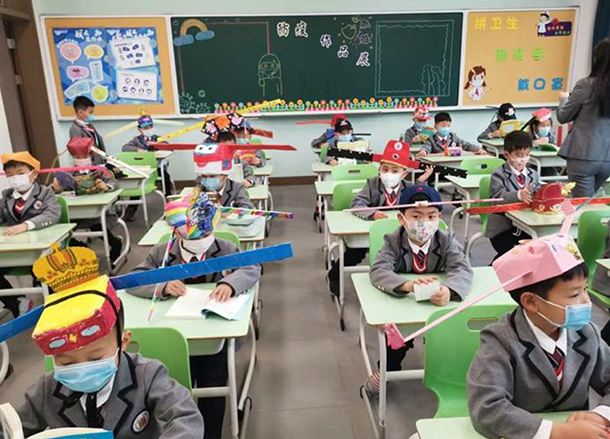
Primary school students created their own winged hats prior to the first day back. The unique head toppers have historical precedence in the hats that prohibited whispering during the Song Dynasty in China (right), and enriches learning while helping to support social distancing.
Approach to Remote and In-Person Teaching
One participant noted that this semester’s online transition has been a success, but that it was based on teachers and students having already had three-quarters of the school year to forge relationships with their students in person. If remote learning continues, how do we create a community at a distance for incoming students in the fall? We rely greatly on physical proximity to engage students and establish relationships, especially for new students. As one participant put it, “What is really essential to building community? Are there ways that we need to be physically proximate to create those relationships? How can our physical spaces allow that in new ways?”
This participant also mentioned that his school is focusing resources on designing a robust online platform as the core experience for students in the fall (and possibly for the year), then looking for opportunities to bring students on campus in a flexible way to build social connection. Specialty classes like art and science which cannot be easily taught remotely are a priority.
Current studies show some asymptomatic people with COVID-19 are still shedding the virus four weeks after. What are we really willing to risk to satisfy our desire to be together?
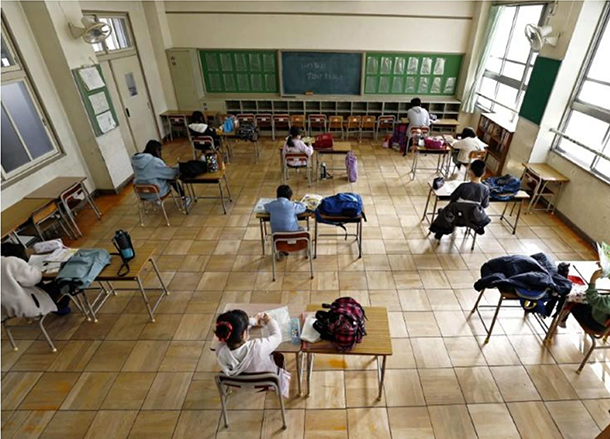
Social distancing within the classroom at an elementary school in Nagoya, Japan.
Approach to Grade Level
The challenges of teaching younger students under pandemic situations are clearly very different from those for high school students. Some schools may prioritize younger students to return to school and continue with online teaching for older students. Remote learning is more feasible for the older ones, who are much more independent. But that doesn’t mean it’s easy. Most of our participants felt it was more pressing to get the younger learners back on campus, both because socialization is so valuable for them, and because caring for the youngest students puts extra pressure on parents trying to juggle working from home.
At the same time, managing safety protocols on school grounds is significantly more challenging for younger students. One participant pointed out: “You’re not going to teach three-, four-, five-, and six-year-olds to maintain distance — unless you put them in Plexiglas cages.” We can make architectural interventions, but “if one kid has a loose tooth, how do you keep other kids from sticking their hands in that child’s mouth to wiggle that tooth? No matter what your rules are, no matter what your website says, kids are going to go ahead and lick each other.”
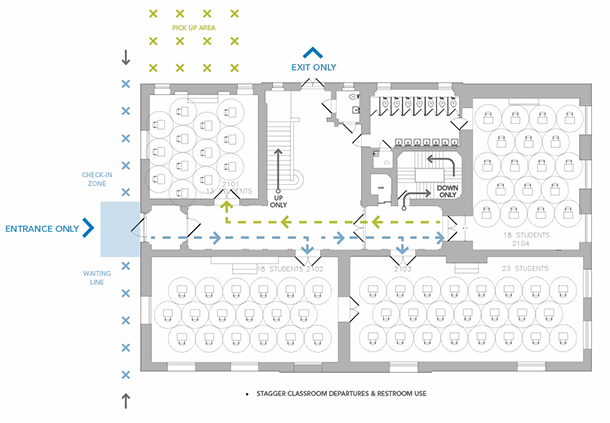
Under new guidelines, classroom density is essentially halved and carefully considered circulation pathways, fixed, to support social distancing and minimize exposure between student cohorts.
Approach to Space
Involving the faculty in planning their classroom spaces is key for some schools. One educator added: “That’s what we’re focusing on, giving our faculty agency within their spaces, to work with me and my team on setting up classrooms for physical distancing.” He noted that diagrams showing physical distancing requirements as circles aren’t as useful for teachers in space planning as more tangible tools. At his school, they’re bringing six-foot-diameter hula hoops into the classrooms to help teachers visualize the space needs. “That tangible piece is powerful,” he said.
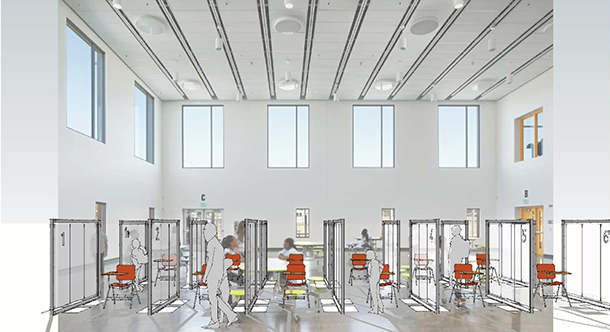
Leveraging gathering spaces, like gymnasiums, for instructional space is a potential strategy for expanding capacity. (Rendering TEF Design)
Approach to Schedule
Schools are looking at how to accommodate fewer students per square foot. If a typical classroom for kindergarteners through second graders holds 20 students, and that capacity is halved under new guidelines, that means finding twice as many spaces in the school building.
Alternatives include staggering students’ schedules so that some are coming in the mornings, others in the afternoons, or they are all coming in every other day or every other week. This would likely require the school year to be extended. “Given how many teachers we have currently, that would probably require a 30 percent increase in expenses” in order to provide for the increased teaching load, according to one educator.
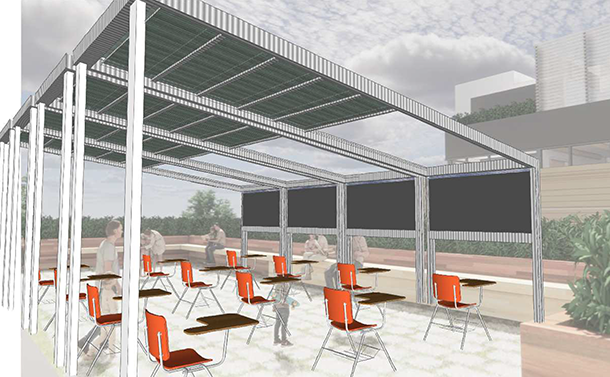
Activating outdoor space, in this case, a roof deck at an urban school, for instructional use, is a potential option, particularly in warmer climates. Other outdoor sources include playgrounds, parking lots, and courtyards. (Rendering TEF Design)
Next Steps
Both the California Department of Public Health and the California Department of Education released guidelines for schools and school based programs last week (and so far, our efforts are in alignment with recommendations). We are currently researching issues such as the City’s regulatory framework and practical strategies for outdoor thermal comfort and improving indoor air quality. We hope to reconvene the forum in the Fall for an assessment of best practices once the school year is underway — assuming that the trajectory towards reopening schools is not interrupted by setbacks.
My sky-high respect for educators has increased exponentially during this crisis. Society is undergoing a massive shift in the way we provide education to our youth and our educational institutions are having to redesign the aircraft while flying, so to speak. Reopening our schools involves some degree of risk for public health, but at the same time, schools are the true backbone of every country’s economy and future.
We can figure out how to minimize the risks and use physical spaces strategically to enhance learning. We’ve seen a wide variety of approaches to adjusting to the new normal, and everything is still evolving. But if we stay flexible and keep the lines of communication open, we can find a way forward together and hopefully use this inflection point in history to rebuild our schools even stronger and healthier than before.